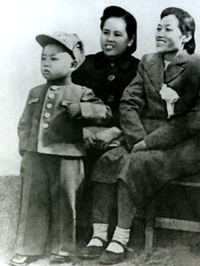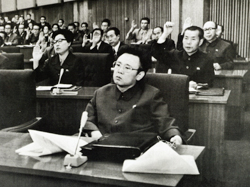| |
|
North Korean leader | Kim Jong-il |
|
|
 Kim Jong-il (1942 ~ )
Kim Jong-il (1942 ~ ) |
 |
| A
young Kim Jong-il and his mother, Kim
Jung-sook(middle) |
|
Kim Jong-il was born on February 16, 1942 to Kim
Il-sung and Kim Jung-sook in Khabarovsk, Russia.
(North Koreans claim that he was born in a military
hideout in Mt. Baekdu of Yang-gang Province’s Samjiyon
County). Currently the most powerful man in North
Korea, he has held office as the General Secretary
of the KWP, Chairman of the NDC, Commander-in-chief
of the KPA, Head of the Republic, member of the
KWP Central Committee and the SPA, Cadre of the
KWP Central Committee’s Political Bureau, etc.
Designated as his father’s successor as early as
the mid 1970s, he began his apprenticeship by taking
office in key positions such as Secretary of the
KWP Central Committee and member of the KWP Central
Committee’s Political Bureau. In 1990, he became
the de facto no.2 man in power by being appointed
as the 1st Division Chief of the NDC, while in 1991,
he took office as Commander-in-chief of the KPA.
The preparatory process for Kim Jong-il’s succession
to power was completed when he became the Chairman
of the NDC in 1993. He overcame the crisis following
Kim Il-sung’s death through the three-year ‘bequest
rule’ period initiated in 1994. Upon his taking
office in 1997 as the Secretary General of the KWP,
the ‘Kim Jong-il Era’ was in full effect. Kim Jong-il
is known to have a love for the arts, especially
cinema.
He has a lively character and is very eloquent in
speech. He has utilized the ‘military first’ slogan
to mobilize the military in creating a firm political
base. Although Kim Jong-il is noted for having introduced
market-based elements into the ailing economy, whether
this measure will be a success is uncertain. The
lack of capital and infrastructure is combining
with the chronic famine problem to bog down the
North’s overall economy. |
|
|
|
 Chronology (1942 ~ 2001)
Chronology (1942 ~ 2001) |
| 1942 |
Born in Khabarovsk, Russia
(North Korea officially claims he was born in a military
hideout in Mt. Baekdu, Yang-gang Province) |
| 1949 |
Death of Kim Jung-sook
(Kim Jong-il’s mother) |
| 1950~1952 |
Chillin School, China
(North Korea officially claims that he took refuge
in Mt. Jangja, Jagang Province during the
Korean War) |
| 1952~1953 |
People’s Class of the
Mangyungdae Revolutionary School |
| 1953~1954 |
Samsuk People’s School
and 4th Pyongyang People’s School |
| 1954~1957 |
1st Primary Middle-school
of Pyongyang (Chairman of the Youth Club) |
| 1957~1960 |
Namsan Advanced Middle-school
of Pyongyang (Chairman of the People’s Youth
Council) |
| 1960~1964 |
Department of Political
Economy, Economics College of Kim Il-sung
University |
| 1961 |
Joins the KWP |
| 1964 |
Director of the KWP Central
Committee’s Organizational Bureau |
| 1966 |
Supervising Director of
the KWP Central Committee’s Organizational
Bureau |
| 1967 |
Section Leader of the
KWP Central Committee’s Arts and Culture Bureau |
| 1970 |
Vice-Chief of the KWP
Central Committee’s Propaganda and Agitation
Bureau |
| 1973 |
Chief of the KWP Central
Committee’s Propaganda and Agitation Bureau |
| 1973 |
Secretary (organizational
and propaganda bureau) of the KPW Central
Committee |
| 1974 |
Member of the KPW Central
Committee’s Political Bureau (designated as
Kim Il-sung’s heir apparent) |
| 1975 |
Receives ‘Hero of the
Republic’ title |
| 1980 |
Cadre of the KWP Central
Committee’s Political Bureau, Secretary of
the KWP Central Committee, Member of the KWP
Military Committee |
| 1990 |
1st Division Chief of
the NDC |
| 1991 |
Commander-in-chief of
the KPA (19th Full Congress of the 6th KWP
Central Committee |
| 1992 |
Head of State |
| 1993 |
Elected as Chairman of
the NDC (5th Meeting of the 9th SPA) |
| 1997 |
Elected as General Secretary
of the KWP (Joint appointment on Oct. 8 by
the KWP Central Committee and Military Committee) |
| 1998 |
Re-elected as Chairman
of the NDC |
| 2000 |
Re-elected as Chairman
of the NDC
Unofficial visit to China (May 29~31)
Summit talks with ROK President Kim Dae-jung
(June 13~15)
Summit talks with Russian President Vladimir
Putin (July)
Meets U.S. Secretary of State Madeline Albright
(October) |
| 2001 |
Unofficial visit to China
(Jan. 15~20) |
| 2001 |
On-site inspection of
Shineuiju facilities (Jan.21~23) |
| 2001 |
Visit to Russia (July)
|
|
|
|
|
 Disagreements on Kim Jong-il’s Birth
Disagreements on Kim Jong-il’s Birth |
There are largely three different versions
of the circumstances of Kim Jong-il’s birth. Different
versions of the story have become problematic
in connection with the justification of his ascension
to power. Because the whole of modern Korean history
had been revised in North Korea to the end of
justifying Kim Il-sung’s one-man rule, and as
the ‘Juche’ ideology was elaborated on to imply
a ‘lineage’ with the purpose of preparing for
Kim Jong-il’s ascension to power, a suitable story
concerning his birth had to fit in with the given
context. The official North Korea claim is that
Kim Jong-il was born in a military hideout in
Mt. Baekdu, which has now become a site of pilgrimage
for all (especially young) North Koreans.
However, the dominant view is that his actual
place of birth was Viatsk - a town 60km away from
Khabarovsk, the site of the headquarters of the
88th Special Brigade of the Soviet Far-East Command’s
Reconnaissance Bureau. A third story claims that
he was born in a Soviet hospital in the Harmataans,
a region located 500km south of Viatsk and in
the middle of Vladivostok and Bolosilov. The entire
debate really arose from the necessity to give
Kim Jong-il a ‘heroic’ place of birth amid the
extraordinary exploits of his father during the
anti-Japanese resistance.
|
|
|
|
 Early Years
Early Years |
Although Kim Jong-il enjoyed affluence since birth
as the son and heir to what may rightfully be called
a kingdom, he did suffer the tragic loss of his
younger brother and his mother in 1948 and 1949.
The Korean War forced Kim to move from school to
school during his primary education. In 1960, Kim
graduated from the Namsan Advanced Middle-school,
mostly attended by children of the most powerful
figures in North Korea.
As a student in the Namsan School, he accompanied
his father to Moscow to visit the 21st Congress
of the Soviet Communist Party in January 1959. Kim
Jong-il apparently had developed a deep interest
in politics by then, as well as aspirations to rise
to power in the future. He devoted much of his time
to ‘serving’ his father and also enjoyed being briefed
by his father’s attendants. According to those who
have met him personally (such as former KWP Secretary
Hwang Jang-yup), he was a bright and curious child. |
|
|
|
 The Apprenticeship
The Apprenticeship |
Directly following his 1964 graduation from the
Department of Political Economy at Kim Il-sung University,
Kim Jong-il began gaining political experience by
participating in KWP Central Committee projects
as a Director of the Organizational Bureau. Promoted
every two years, in 1967 he was appointed Section
Leader of the Propaganda and Agitation Bureau, of
which he was made Vice-Chief in 1969. In 1971, he
became Chief of the Arts and Culture Bureau, while
in 1973, he was elected both Secretary of Organization
and Propaganda and Chief of the Organizational Bureau
(September, closed-door meeting of KWP Central Committee).
It was around this time that he emerged as Kim Il-sung’s
heir apparent.
 |
| Kim
Jong-il is appointed as cadre of the
Politburo in a 1980 Congress of the
KWP Central Committee |
|
At the February 1974 8th Full Congress of the 5th
KWP Central Committee, he was appointed as a member
of the Central Committee’s Political Bureau (Politburo),
and oversaw actions to “have the Dear Commander
Kim Jong-il succeed the Great Chairman”. After this
day, Kim Jong-il was never addressed by his name
but as the ‘Center of the Party’. In February 1975,
the 10th Full Congress of the 5th KWP Central Committee
unanimously conferred upon him the title ‘Dear Commander’.
Kim Jong-il’s position as heir apparent had been
thus solidified.
In North Korea regime, power stemmed from the Party.
In particular, organization and propaganda formed
the core of Party activity. Kim Jong-il had prepared
for his ascent to power through taking office in
sectors dealing with these very tasks as well as
working as a member of the Political Bureau, another
core of power within the KWP. It can therefore be
said that Kim Jong-il’s ascension to power was some
two decades in the making. |
|
|
 |
|